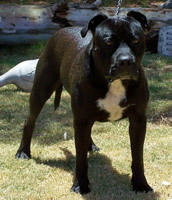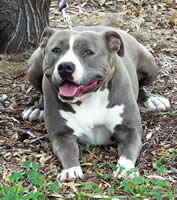BREED DESCRIPTION:
STRUCTURE:

The American Staffordshire is a very muscular, stocky yet agile dog, and is extremely powerfull for his size. He has a broad powerfull head and very strong jaws. Although over seas their ears are generally cropped, here in Australia they are left alone. The eyes are round and dark. Teeth should form a scissor bite. It's coat is made up of thick, short shiny hair. They are available in most colors how ever if you want an Amstaff for the show ring it's coat must not be more than 80% white. The tail should taper to a point.
LIFE EXPECTANCY:
About 9 - 15 years.
GROOMING:
The smooth, short haired coat is easy to groom. Brush on a regular basis with a firm bristle brush, and bathe or dry shampoo as necessary. A rub with a piece of towling or chamois will make the coat gleam.
TEMPERAMENT:

The Amstaff is a happy, out going, stable, and confident dog. Gentle and loving towards people. Good natured, amusing, extremely loyal and affectionate pet. It is good with children and adults. The Amstaff is almost always obedient, and wants nothing more than to please it's master. The Amstaff is an extremely courageous and intelligent guard dog that is very full of life and character. Over the past 50 years, carefull breeding has produced this friendly, trustworthy dog who is an especially good dog for children. He is a courageous and persistant fighter if provoked. The Amstaff is highly protective of both his owner and his owners property. He will willingly fight an enemy to the death if the enemy traps him in a corner and threatens his loved ones. This breed has a very high tollerence for pain. The Amstaff must be socialised at a young age to ensure that any dog aggression tendencies are curved. This breed has given outstanding results as a guardian of property, but at the same time esteemed as a companion dog. When properly trained and socialised the Amstaff makes a great family companion.
RECOGNITION:
The Amstaff is a recognised breed by the following organisations.....
- ANKC - Australian National Kennel Club
- CKC - Continental Kennel Club
- NZKC - New Zealand Kennel Club
- NKC - National Kennel Club
- FCI - Federation Cynologique Internationale
- AKC - American Kennel Club
- CKC - Canadian Kennel Club
- APRI - American Pet Registry Inc.
- ACR - American Canine Registry
ANKC STANDARD
Group: | Group 2 (Terriers) |
General Appearance: | The American Staffordshire Terrier should give the impression of great strength for his size, a well put-together dog, muscular, but agile and graceful. He should be stocky, not long-legged or racy in outline. |
Characteristics: | (Not specified.) |
Temperament: | Keenly alive to his surroundings. His courage is proverbial. |
Head And Skull: | Head medium length, deep through, broad skull, very pronounced cheek muscles, distinct stop. Muzzle medium length, rounded on upper side to fall away abruptly below eyes. Jaws well defined. Underjaw to be strong and have biting power. Lips close and even, no looseness. Nose definitely black, Dudley nose undesirable. |
Eyes: | Dark and round, low down in skull and set far apart. Light or pink eyes undesirable. No pink eyelids. |
| Ears: | Set high. Ears should be short and held rose or half pricked. Full drop to be penalised. |
| Mouth: | Upper teeth to meet tightly outside lower teeth in front. Undershot or overshot mouths undesirable. |
| Neck: | Heavy, slightly arched, tapering from shoulders to back of skull. No looseness of skin. Medium length. |
| Forequarters: | Shoulders strong and muscular with blades wide and sloping. The front legs should be straight, large or round bones, pasterns upright. No resemblance of bend in front. Forelegs set rather wide apart to permit chest development. |
| Body: | Back fairly short. Slightly sloping from withers to rump with gentle short slope at rump to base of tail. Well sprung ribs, deep in rear. All ribs close together. Chest deep and broad. Loins slightly tucked. |
| Hindquarters: | Well muscled, let down at hocks, turning neither in nor out. |
| Feet: | Of moderate size, well-arched and compact. |
| Tail: | Short in comparison to size, low set, tapering to a fine point; not curled or held over back. Not docked. Tail too long or badly carried undesirable. |
| Gait/Movement: | Must be springy but without roll or pace. |
| Coat: | Short, close, stiff to the touch, and glossy. |
| Colour: | Any colour, solid, parti, or patched is permissible, but all white, more than 80% white, black and tan, and liver not to be encouraged. |
| Sizes: | Height and weight should be in proportion. |
| Faults: | Any departure from the foregoing points should be considered a fault and the seriousness with which the fault should be regarded should be in exact proportion to its degree. |
| Notes: | Male animals should have two apparently normal testicles fully descended into the scrotum. |



